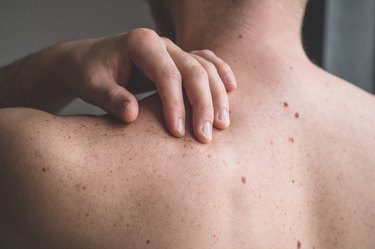
You might notice a mole when you glance at your skin or take a look at yourself in the mirror. But if a brown spot or beauty mark is grabbing your attention because it's itchy, you might wonder whether that's normal.
Skin irritation can occasionally trigger the urge to scratch. That said, "moles typically do not itch," says Brendan Camp, MD, a double board-certified dermatologist at MDCS Dermatology in Manhattan and clinical assistant professor of dermatology at Weill Cornell Medical College. "A mole that is persistently itchy should be examined by a dermatologist."
Video of the Day
Video of the Day
Here's how to tell what might be affecting your skin and how to ease the irritation. Plus, when you should be concerned about an itchy mole.
Types of Moles
Moles, or nevi, are round skin spots that are often brown but can also be tan, black, red, pink, blue or skin-toned. They can be flat or slightly raised, but their size and shape should stay consistent over time.
Per the Cleveland Clinic, there are three types of moles:
- Common nevi: These are the typical spots most of us have on our skin. Common moles have distinct edges that look different from the rest of your skin.
- Congenital nevi: Congenital moles are found on a person at birth. Larger congenital nevi may be more likely to turn into melanoma compared to common moles.
- Dysplastic nevi: These moles are larger than a pencil eraser and have an irregular (not round) shape. Dysplastic nevi tend to be more common on people who have more than 100 moles and can increase a person's risk for skin cancer.
Causes of Itchy Moles
Scratchy spots can happen from minor irritation, but they can also be a sign of a more serious skin problem. Here's how to tell the difference.
1. Irritated Skin or an Allergic Reaction
A mole can sometimes become itchy or inflamed from friction, like if it rubs up against an article of clothing, Dr. Camp says.
It's also possible for the mole and surrounding skin to have an allergic reaction to an ingredient in a personal care product, soap or laundry detergent.
In either case, you might also notice some redness or a rash around the mole.
Fix It
Take off the garment or avoid the substance that seems to be irritating your mole.
If you need more relief, apply a corticosteroid ointment or anti-itch cream — like Cortizone 10 ($8.48, Amazon) to calm the inflammation and relieve the itching, recommends the Mayo Clinic.
2. Eczema or Dry Skin
Parched, flaky skin and moles can be prone to itching, especially if you have a condition like eczema, Dr. Camp says.
If dryness is the culprit, you'll probably notice itching around a larger area of skin beyond just your mole. The affected skin might also feel thick, leathery or swollen.
Fix It
See your dermatologist if you think you have eczema, recommends the Mayo Clinic. Together, you can come up with an eczema-management plan that includes using regular moisturizer throughout the day, avoiding triggers that irritate your skin and using topical ointments or oral medications to keep your symptoms in check.
If dry skin is the issue, try moisturizing regularly, showering with warm water (instead of hot) and a fragrance-free body wash, running a humidifier and limiting your sun exposure.
3. Bug Bite
If a mosquito or another bug happens to make a bull's eye out of your mole, your beauty mark might get itchy or swollen, Dr. Camp points out.
You might notice some redness around the mole, too, especially if you've been scratching a lot.
Fix It
Bug bites usually go away on their own within a few days. You can ease the itching in the meantime by applying a cool compress or dotting on some calamine lotion, the Mayo Clinic says.
Other natural remedies for bug bites include dabbing honey, witch hazel or aloe vera on the area, or applying a cool, used tea bag like a compress.
4. Skin Cancer
A mole that's persistently itchy, irritated or bleeding could be a sign of a more serious condition like skin cancer.
"It doesn't automatically make it skin cancer, but the mole should be reviewed by a board-certified dermatologist," Dr. Camp says.
While anyone can develop skin cancer, your risk is higher if you have light-colored skin, blonde or red hair, blue or green eyes or you tend to sunburn easily, according to the Centers for Disease Control and Prevention (CDC).
How to Tell if an Itchy Mole Is Cancerous
The only way to know if a mole is cancerous is by seeing a dermatologist. They'll need to examine the mole and may test a sample of it in order to give you an accurate diagnosis, Dr. Camp says.
That said, moles with certain characteristics are more likely to be cancerous. Per the American Academy of Dermatology (AAD), you should let your dermatologist know about moles that have any of these traits:
- Asymmetrical: One side is not like the other
- Border: The edges of the mole are irregular
- Color: The mole isn't the same color all over
- Diameter: The mole is the size of a pencil eraser or bigger
- Evolving: The mole looks or feels different than the rest or is changing in size, shape or color
Not every cancerous mole will meet this description, and not every skin growth that does turns out to be skin cancer.
That's why it's a good idea to touch base with your dermatologist if you notice any mole or sore that looks or feels different from the others on your body, the American Cancer Society says.
If it's itching, uncomfortable, swollen, tender or is irritating you and isn't getting better, play it safe and call the doctor.
Skin Cancer Treatments
Skin cancer is highly treatable when it's caught early, though the specific therapy will depend on your mole and its symptoms.
"Most forms of melanoma can be treated with excision or complete removal," Dr. Camp says.
Further treatment may be needed depending on the mole, its severity and where it's located.
More severe cases of skin cancer may require radiation therapy, chemotherapy, photodynamic therapy or biologic therapy to kill cancer cells, says the Mayo Clinic.
When to See a Doctor About an Itchy Mole
You should let your dermatologist know if you have an itchy or irritated mole that isn't getting better with at-home treatments, or if the mole looks different than the other moles on your body.
And don't delay: The sooner you can get it checked out, the sooner you can start appropriate treatment.
- Cleveland Clinic: "Moles"
- Cleveland Clinic: "Eczema"
- Centers for Disease Control and Prevention: "What Are the Risk Factors for Skin Cancer?"
- American Academy of Dermatology: "MOLES: SIGNS AND SYMPTOMS"
- American Cancer Society: "How To Spot Skin Cancer"
- Mayo Clinic: "Itchy Skin (Pruritis)"
- Mayo Clinic: "Insect bites and stings: First aid"
Is this an emergency? If you are experiencing serious medical symptoms, please see the National Library of Medicine’s list of signs you need emergency medical attention or call 911.





